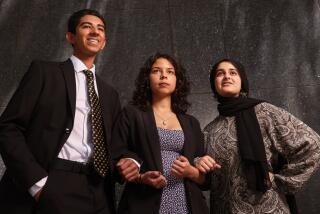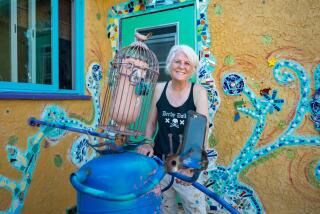Youths Carve a Gift of Peace for N.Y.
SALINAS, Calif. — Joseph Werner has never seen the healing pole. But he recognizes the pungent smell of the 1,100-year-old cedar.
He knows it’s 2 1/2 stories tall and two arms’ length thick. He’s told that the protective lacquer makes it turn the color of maple syrup in the sun. And when he slides his fingers over the bumps and grooves carved into the log by troubled teenagers during the last two years, he can feel the shapes of dolphins, owls and bears.
Werner lost his sight in a hit-and-run car accident 20 years ago, but the Monterey County youth leader believes the majestic carving, which resembles a totem pole, has a certain power. He and the teens in his charge, who painstakingly produced it with the help of a master artisan from New Zealand, now hope it will bring peace to New Yorkers mourning the losses of Sept. 11.
In Polynesian and Native American traditions, the carved wood is believed to take on healing powers through its creators, who exorcise their sorrows through their hammers and chisels. Today, the pole will be tied to a truck in Salinas and driven to New York City’s Bronx Zoo, its new home.
A Fresh Start
The journey marks a new beginning for many of the youths, who had been struggling with problems ranging from truancy to drug abuse, and for the log itself, which came from Alaska. It was brought to California in the 1920s by the Navy, which used it to support a pier at an ammunition depot in Port Chicago, 35 miles north of San Francisco.
The pier was destroyed in an accidental explosion in 1944 that killed 320 servicemen, two-thirds of them African American cargo handlers working without safety equipment. The blast, which registered 3.5 on the Richter scale, is credited by military historians with initiating the debate on desegregating the Navy.
The log was tossed on the banks of Suisan Bay in the 1980s. A decade later, it and nine others from the pier were about to become firewood. A group of environmentalists bought them and gave three to Werner’s One Voice Arts and Leadership Program, a state-run federal project. Shane Eagleton, the New Zealand artist who has been working with the program since 1998, took on 12 of Werner’s charges in the summer of 2000 to carve the pole. Their goal was to give the finished work to a community coming to grips with some sort of tragedy.
Using 27 chainsaws of different sizes, Eagleton made a double-helix pattern around the log. The twisting strands represent the continuity of nature and the links among people of different backgrounds and races. His hope was that the concept would inspire the youths and broaden their horizons.
“A lot of these kids were rough in the center,” said Eagleton, who is currently working with youths in Hawaii and has provided stage art for touring bands such as Pink Floyd and the Grateful Dead. “They never worked with art, and coming from low-income families, they didn’t have a lot of outlets to express themselves.”
Johnny Esquivel, one of the 12 teens, said he and the others were initially intimidated by the project because they had never tried woodcarving and feared it would be beyond their skills. However, he was intrigued by Eagleton, whose encouragement was unrelenting. “I didn’t know if I could do it,” the 18-year-old said. “But as I kept going, I decided to follow through. I did my best and I got better at it. I finished what I started and I never missed a day.”
Esquivel had just been through a tough year. He was expelled from his high school for skipping too many classes and had to finish 10th grade at a continuation site. After working on the pole, he said, he was able to resume his studies. He made up lost credits and graduated on time last spring. His next goal is community college.
Demetrious Huggins, 19, often smoked marijuana and drank before a friend suggested he join One Voice, where he volunteered for the healing pole project. He was so moved by the experience that summer that he wrote an essay about how working on the carving team changed his life, saying it was important “not to waste any more time” and he wanted to “use all of [his] ability to help others.”
Huggins enrolled in remedial classes to earn his high school diploma, which he expects to receive next month.
Huggins and the others worked in a chilly warehouse with no electricity at the abandoned Fort Ord Army base nearby. Carving sessions lasted from 8 a.m. to 4 p.m. to capitalize on sunlight. At first, the wary teens formed cliques along racial lines: African American, Asian, Latino. But within a couple of weeks, they were hammering in rhythm, marveling at the centuries-old pockets of wet resin still trapped in the wood.
The teens learned to share the precious surface of the pole, coordinating the outcomes of their designs so as to not interfere with one another. They took field trips together to the aquarium and the beach. Soon the two girls with cars started giving the group rides to town to grab lunch.
As the days passed, the renderings on the pole became clearer. The work became easier. The young workers’ confidence soared.
“The good thing about woodcarving is that you can’t really mess up, you just chisel deeper,” said 18-year-old Jaymes Lambert, a childhood friend of Huggins’ who now also attends remedial classes.
By the end of the eight-week project, the moldy three-ton log had been transformed into an intricate display of wildlife images: a grizzly bear, a bottlenose dolphin, a jellyfish. At the top of the pole sits a phoenix with its wings spread.
The teens were paid $2,500 each for their work--a lot of money for youths from newly arrived immigrant families, financially strapped single-parent households or homes where nobody was employed. Huggins said he gave most of his earnings to his mother to help pay the rent.
At the end of the summer, when the project was nearly done and the teens had to go back to school, no home had been chosen for the pole. So it remained in a warehouse. Another summer came, and with it a new group of teens, who added scales to the pole’s fish figures and feathers to its birds. Then came Sept. 11, and a home for the healing pole became “painfully obvious,” Werner said.
Perfect Environment
A Bronx native, Werner thought of the zoo as the perfect environment for the pole’s wildlife motif. But zoo administrators seemed lukewarm. So he mailed them a video documentary on the making of the pole.
What the zoo officials saw on the tape included an emotional candlelight vigil around the pole in Palm Springs, where it was displayed for 600 participants in California youth programs. Also on the video were some of the original 12 teens, recounting their work and the feeling of accomplishment it provided.
Shortly after, Werner told the zoo representatives about the Monterey County police and firefighters who had the outlines of their hands carved into the pole in solidarity with their New York counterparts.
The pole’s history and the project’s impact on the teens proved irresistible. “We were knocked flat,” said Steven Sanderson, president of the Wildlife Conservation Society, which runs the zoo.
The pole is expected to arrive in New York on Wednesday. On Sept. 5, it will be unveiled beside a waterfall in the zoo. Werner and Eagleton will meet the pole in New York, and Huggins and Lambert, the only two of the original 12 still involved with One Voice, will also be there.
“I can envision thousands of people applying their personal experience to this pole,” said Werner, who credits the project with helping him finally forgive the people who crashed into his motorcycle and left him for dead years ago.
“Whether it’s divorce, hardship, lost loved ones, hunger or poverty, they can look at what these people have created with this project and heal together.”
More to Read
Sign up for Essential California
The most important California stories and recommendations in your inbox every morning.
You may occasionally receive promotional content from the Los Angeles Times.











